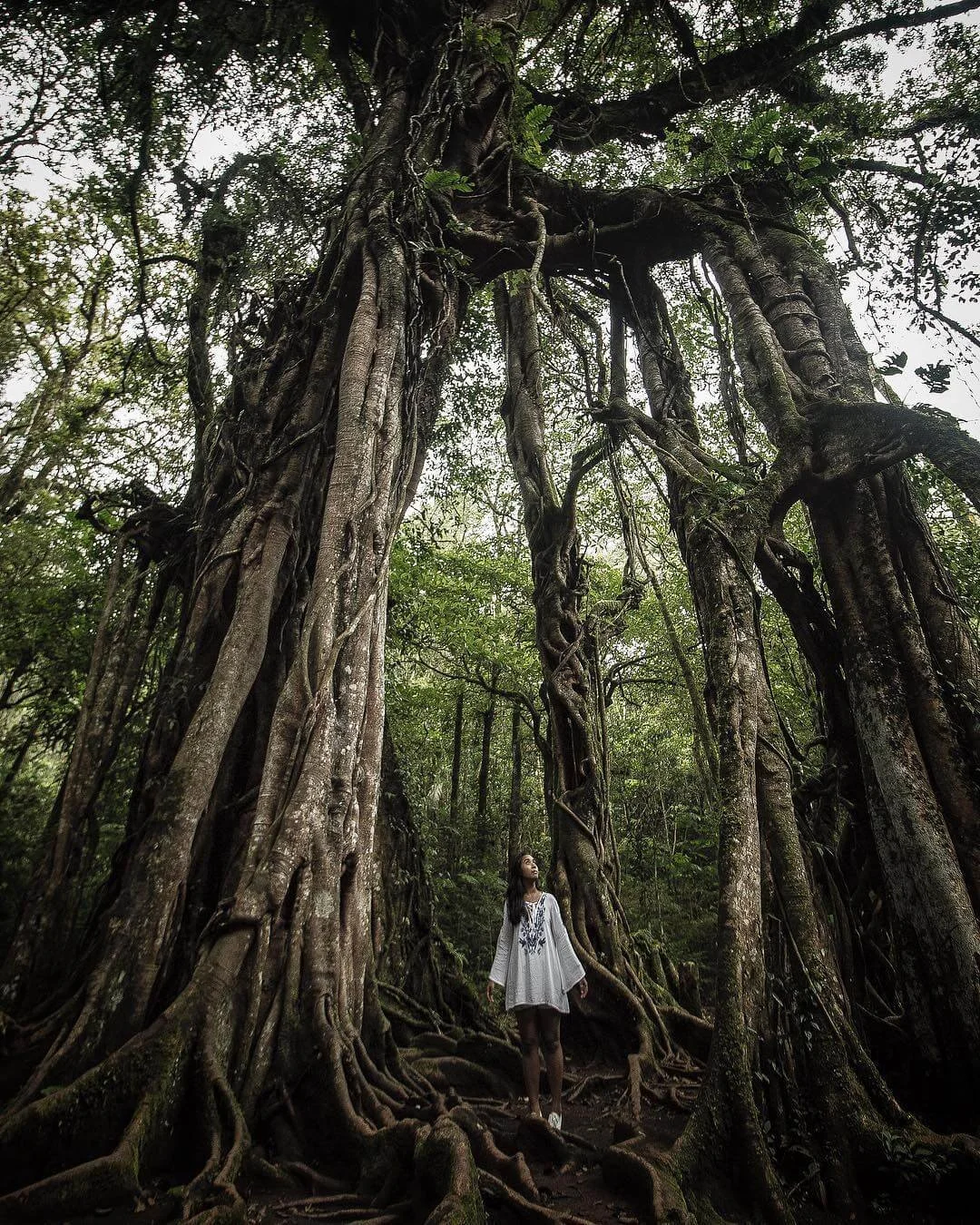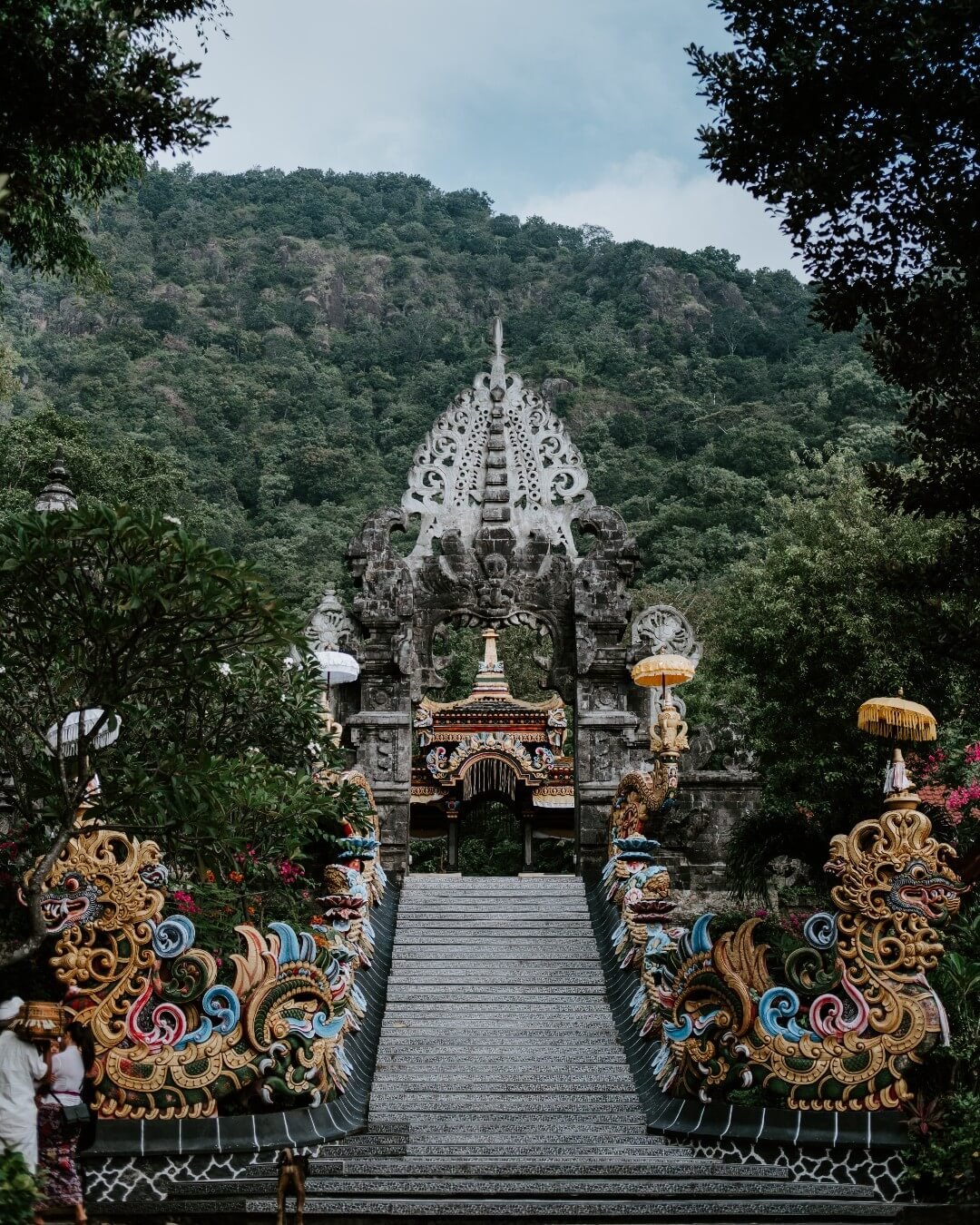Bali Bedugul Botanic Garden: A Dig-Deep Guide to This Garden Of Eden
Indonesian Name: Kebun Raya Bali
Bali Bedugul Botanic Garden | Image: Josh Kathey
Table of Contents Show
Visit with a tour
Introduction
Located in the heart of Bali, Bedugul is a picturesque mountain village that offers travelers a unique opportunity to experience the beauty and culture of this remarkable island. It is an ideal destination for those who seek adventure, relaxation or simply to discover the many hidden gems that can be found here.
The area is surrounded by lush tropical rainforests, dramatic mountains and stunning views of Lake Bratan, which is home to a variety of water animals and plants that make it a perfect spot for bird watching or fishing. The lake has also become an important source of hydroelectric power for the island.
Bedugul is also home to one of Bali's most beautiful botanical gardens, known as Bali Botanic Garden. This 30-hectare park features a diverse collection of flora from all over Indonesia and beyond, making it an ideal place to explore the natural world around you. Visitors can learn about local plant species as well as observe rare species from other parts of the world.
Indeed, Bali Botanic Garden is Indonesia's largest botanic garden, making it a compelling stop on a Bali tour for any garden lover. That is why why over 500,000 visitors come here to the highlands of Bali every year.
For visitors who crave more adventure, Bedugul offers plenty of outdoor activities such as trekking, mountain biking and rock climbing. There are also several temples nearby including Pura Ulun Danu Beratan temple which sits on the lake's edge with breathtaking views across the lake and mountains beyond.
For those who appreciate the arts and culture, Bedugul has something special in store too - traditional dance performances celebrating Hindu mythology tell stories through music and movement, while vibrant music festivals bring together locals and visitors alike in celebration of Balinese culture.
From its stunning scenery to its rich cultural heritage, Bedugul provides visitors with a truly unforgettable experience – one that will remain forever etched in their memory.
Address
Jl. Kebun Raya, Candikuning, Kec. Baturiti, Kabupaten Tabanan, Bali 82191, Indonesia (See on Google Maps)
Location
Bali Botanic Garden is located in Bedugul and can be accessed by car or public transport from Denpasar or other nearby cities.
Address & Phone Number of Nearest Hospital for Emergency
The nearest hospital for emergencies is Rumah Sakit Umum Pusat Sanglah (General Hospital of Central Sanglah), located at Jalan Diponegoro No. 72, Denpasar, Bali 80114. The emergency number is +62 361 227 911.
Organise Bali travel insurance to cover your visit in case of an accident.
Three Key Reasons To Visit
Breathtaking Scenery: Bali Botanic Garden is located in the Bedugul area, surrounded by mountains and a beautiful lake. Here you can witness the beauty of nature combined with man-made attractions like cascading waterfalls, gazebos, conservatory (greenhouse tropical and dry gardens) and terraced gardens. You can also observe a wide variety of flora thriving in this environment, providing you with a unique experience that is sure to stay with you for many years.
Exploring Nature's Wonders: Bali Botanic Garden is home to many rare species of plants native to Bali as well as some exotic species from around the world. This is your chance to explore nature's wonders on an intimate level with guided tours and informative displays that explain local flora and fauna. With more than 300 species of plants to explore, there is something here for everyone!
Relaxation Retreat: The tranquil atmosphere of Bali Botanic Garden makes it an ideal place for relaxation and reflection. Whether you are looking for a peaceful stroll or just want to take in the scenic views, this botanical garden has something for everyone. In addition, its lush greenery provides much-needed shade from the hot Bali sun, making it the perfect place to spend some time outdoors while still being able to cool off in style.
History, Myths and Legends
The Bali Botanic Garden was established on 15 July 1959, a monumental day for the Balinese people as the “Eka Karya Botanic Garden” – first creation – was opened in honor of Indonesia’s newly gained independence. The sun shone brightly from the cloudless sky and a gentle breeze rustled the leaves of the towering conifers, originally intended to decorate and provide recreation for visitors.
But just 6 years later, in 1965, development of the garden abruptly stopped due to political instability. Ten years passed before the garden was opened again on the 30th of April 1975; now expanded to 129 hectares and with a new purpose to conserve plants from the mountainous regions of Eastern Indonesia. Another 20 years later in 2001, the land area was extended again and now reaches a total of 157.5 hectares.
What To Expect When Visiting
Visitors to Bali Botanic Garden can expect an awe-inspiring experience in a lush and exotic environment. This huge garden, located in the mountainous region of Bedugul, is filled with over 1000 species of plants, many of which are native to Indonesia. The garden offers spectacular views of Mount Agung and nearby Lake Bratan and is surrounded by terraced rice paddies. There is also a variety of wildlife, including bird watching spots and areas designated for butterflies.
Upon arriving at Bali Botanic Garden, visitors will be welcomed by friendly staff who will guide them through the grounds. A wide range of activities are available such as guided tours, nature walks, and educational programs. Visitors can explore the various pathways that lead to different parts of the garden or take a leisurely stroll around the lake. For those looking for more adventurous activities, there are opportunities to trek through the jungle or take a boat trip across Lake Bratan.
The Bali Botanic Garden features a diverse collection of plants, including a display of around 100 species of begonias, with three endangered species unique to Bali. The collection also includes the largest collection of wild orchids in Bali, with around 300 species on display, including several rare and endangered species. The Gardens also have a focus on preserving Indonesia's rich diversity of wild orchids.
The new Conservatory Building, completed in 2016, houses a collection of plants that follow the evolutionary path of plant life on Earth, including the rare and hybrid plants, such as the titan arum. The garden also has a collection of carnivorous plants from the genus Nepenthes, which are native to Indonesia. Additionally, the garden features a 1.6-hectare display of traditional medicinal plants and a bamboo garden with 87 species, six of which are endemic to Bali. The Fern Garden is also one of the largest collection by area, featuring tree ferns, bird's-nest ferns, and elephant trunk ferns.
The Bali Treetop Adventure Park is an outdoor activity located within the Bali Botanic Garden, offering a series of rope-walking circuits with physical challenges and zip-lines suspended up to 20 meters above the ground among the rasamala trees. The park caters to both children and adults with varying levels of difficulty. Note that separate entry fees apply for the treetop park.
The Bali Botanic Garden is recognized as a leading research center for plant biodiversity and conservation in Indonesia. It conducts research in the fields of horticulture, plant biodiversity, and conservation, with a focus on rare and endangered species from Eastern Indonesia. The botanic garden only accepts plants and seeds with known provenance and that have been collected and imported legally. They also screen and evaluate plants that could be invasive, have potential for genetic pollution, or introduce pests or diseases. The garden provides a number of scientific services and facilities to support research and conservation, including a seed bank, herbarium, tissue culture laboratory, greenhouses, nursery, library, and plant database. With over 2,400 species of plants, the Bali Botanic Garden serves as a valuable resource for plant genetics, which could be useful for future restoration purposes. The garden also produces Kompenit, a high-quality nitrogen-fixing compost product that is available for commercial use.
The best time to visit Bali Botanic Garden is during the dry season (April-September) when temperatures remain relatively mild and rainfall is minimal. During this time, visitors can expect clear skies and sunny days that make exploring the garden even more enjoyable.
However, don't discount the beauty of the rainy season either - the gardens are glistening, everything is fresh and experiencing intense growth, spurred on by the warmer weather and abundant rain. If it does rain whilst you are there, it probably won't last long and whilst it's raining you can take the opportunity to explore the conservatory gardens under full cover.
Photo Opportunities and Tips
Visiting Bali Botanic Garden offers visitors a unique opportunity to take some amazing photographs of the beautiful scenery. The best time to visit is during the early morning when the sun is not too strong, as this will give you the clearest views of the garden. The garden itself features many different types of plants, flowers, trees and fountains which make for wonderful photo subjects. Additionally, there are plenty of interesting pathways that lead through the forested area providing opportunities for great landscape shots.
There is a reason this is one of the most favoured pre-wedding and wedding photography locations for the Balinese. You can expect to see bridges around the garden and you are welcome to take inspiration from their location choices to pick spots for your own photography.
What Visitors Say They Liked About Visiting
Many visitors to Bali Botanic Garden comment on how peaceful and tranquil the atmosphere is. There are very few other people around, allowing you to truly relax and take your time appreciating nature in its purest form. Others mentioned how well maintained everything was, with lush green foliage everywhere that made for a great backdrop for photographs. Additionally, there were plenty of benches and seating areas where visitors could take a break from exploring and take in all that nature had to offer.
What Visitors Say They Did Not Like About Visiting
The only complaint from visitors was that there were no cafes or restaurants located in close proximity to the gardens, making it difficult to grab a quick bite while taking a break from exploring. However, those who come prepared with snacks can easily set up picnic areas near one of the ponds or streams throughout the garden.
How Accessible is it for The Elderly, Children and Those With Mobility Issues?
The Bali Botanic Garden is generally accessible for the elderly, children, and people with mobility issues. The garden has several paved pathways throughout the grounds that can be navigated easily by those with limited mobility. You can actually drive through the gardens on designated roads. There is also a shuttle service available to take visitors from one end of the garden to the other. Additionally, there are benches and chairs located throughout for those who need to rest or take a break.
For those with more serious mobility issues, it may be difficult to access some of the more remote areas of the garden. However, there are still plenty of accessible spots that can be enjoyed without having to travel too far.
It is important to note that due to its location in a tropical climate, it can get quite hot and humid during certain times of year. This should be taken into consideration when visiting the Bali Botanic Garden as it may not be suitable for those with certain medical conditions or physical limitations.
Safety Tips When Visiting
Visiting the Bali Botanic Garden is a great experience and with the right safety measures it can be a memorable one. Here are some tips to help your visit run smoothly:
Check the Weather Report and Wear Appropriate Clothing: The weather in Bali can change quickly, so checking the forecast beforehand and wearing layers is important. Be sure to wear comfortable shoes as you will likely be walking around for a while.
Be Aware of Wildlife: When exploring the gardens, be aware of any wildlife you may encounter. Some animals might appear friendly but could be dangerous if not handled correctly so it’s best to keep your distance and let them roam free in their natural habitat.
Stay Hydrated: It’s important to stay hydrated when spending long periods of time outdoors, especially in hot climates like Bali. Make sure to carry plenty of water with you, or purchase some at designated kiosks located around the garden.
Stick to Pathways: To ensure safety, it is important to stay on designated pathways at all times during your visit. This will help you remain on track and avoid any potential danger that may be lurking off-pathway such as slippery surfaces or wild animals.
Typical Amount of Time to Allocate for a Visit
The Bali Botanic Garden, located in Bedugul, has become an increasingly popular tourist spot due to its lush greenery and breathtaking views. Some people may want to spend a few hours here, but if you really want to take in the beauty of the garden and everything it has to offer, then you should allocate at least half a day for your visit.
Most tourists tend to spend around 4-5 hours in the garden. This will allow you enough time to explore all areas of the park and appreciate its natural beauty. It is also important that you plan your visit according to the time of year; certain plants may only be in bloom during certain seasons, so try and plan your trip accordingly. During peak season, there are also special events like art exhibitions and concerts which can make your experience even more memorable.
Apart from taking leisurely strolls through the path while admiring nature’s splendor, visitors can also enjoy activities such as bird watching or exploring the diverse range of plant species which are housed here. There is a café located within the garden where people can stop for lunch or tea break before continuing with their exploration.
In addition, visitors should also take some time out for souvenir shopping at the end of their visit; there are plenty of unique items being sold at kiosks located nearby which would make wonderful reminders of this beautiful spot!
Food and Drink Options Nearby
The Bali Botanic Garden is close by many food and drink options that will cater to every visitor’s taste buds. If you’re looking for something light yet delicious, then head over to Warung Makan Bujana which serves up traditional Balinese dishes such as Nasi Goreng (Indonesian fried rice) or Mie Goreng (fried noodles).
For those who fancy Italian fare, Sala Bali Restaurant & Lounge offers woodfire oven pizzas as well as pasta dishes made with locally sourced ingredients. Wash down your meal with one of their signature cocktails or mocktails – perfect after a long day strolling through the garden!
If seafood is more your thing then try Taman Rama Seafood Restaurant where they serve up mouthwatering grilled fish along with other local delicacies like Ayam Betutu (smoked chicken). For dessert, don’t forget to grab some freshly made es cendol (coconut ice cream) from nearby stalls- an absolute must-have when visiting this part of Bali!
Conclusion
The Bali Botanic Garden is an incredible place to visit in Bali. With its lush, tropical gardens and stunning views of the surrounding area, it provides a beautiful setting for visitors to explore and relax. Visitors can take part in guided tours of the gardens, learn about the plants, animals, and history of the area, or simply enjoy a peaceful stroll through nature. The best part about visiting the Bali Botanic Garden is that it is free to enter and provides a unique opportunity to experience some of Bali's most beautiful natural wonders.
Discover more destinations in North Bali


































